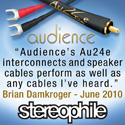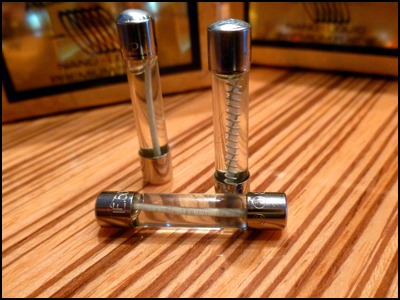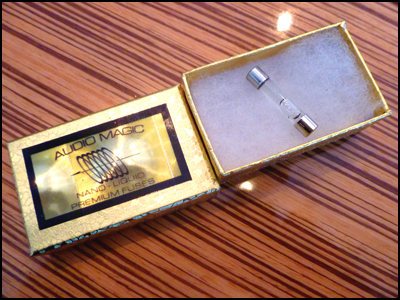|
|
You are reading the older HTML site
Positive Feedback ISSUE 61
audio magic Nano-Liquid Fuse as reviewed by John Hoffman
There are many paths to audio nirvana in this hobby, although two distinct philosophies often dominate the landscape. There is the empirical school of thought that believes that every aspect of audio reproduction can be explained by the current body of electrical knowledge. Audio gear is measured and evaluated with test equipment, and any differences between components can be explained and mathematically verified. On the other end of the spectrum is the subjective audio hobbyist who cares very little for measurements and test tone sweeps, for it is their world view that music is a far more demanding test than a series of tone bursts are. These hobbyists often look upon the current body of audio science as incomplete, and incapable of accurately describing every event that is experienced. As you might expect there is friction between these two schools of thought, and it has created a dichotomy within this hobby. Personally, I value the contributions of both schools of thought, and attempt to listen to and evaluate the recommendations of each side. Measurements are critical to designing a component, after all a designer must have a knowledge base to work from when developing a circuit. On the other hand, there are certainly events in audio that are not adequately explained by conventional audio rationalism. This is the mystical side of audio, that many do not wish to acknowledge, or are afraid to explore. The rational person tries to explain it away by saying the mind hears only what it wants to hear, and that the concept of unmeasurable audio phenomena is charlatanism at its worst. While I tend to be pragmatic in nature in terms of my audio philosophy, it is time to enter into the twilight realm of our hobby, and explore the nuances that the Audio Magic Nano-Liquid fuses have to offer. The Nano-Liquid fuse is based upon a common electrical fuse. The first step in converting this humble fuse into a unique audio device is to drill a minuscule hole slowly and carefully into an end cap, which is a difficult task to accomplish without damaging the filament. Then an opaque dampening fluid is injected through the hole, and surrounds the fuse filament. The process does not completely fill the entire chamber, for there is a small air bubble remains on the end. For all practical purposes, the level of immersion of the filament is more than enough to dampen it. A quick touch of a soldering iron seals the hole, and the fuse is ready for the Nano-Stream treatment. The purpose of this process is an enhancement of the conductivity fuse, and has previously been applied to the higher tier cables in the Audio Magic product line. The entire process is labor intensive, and several fuses are lost before one is completely modified. Each Audio Magic fuse sells for $60, which puts it in the center of the pricing spectrum for high performance fuses.
Does the modification process change the failure mechanism of the fuse? This is a topic that has been raised in discussions of the Audio Magic fuse. There is also a question of whether a fuse could leak and what the effect the polymer would have on an electrical board. Audio Magic states that the polymer is non-corrosive and non-conductive, so it will not harm the boards inside a component. During the prototyping process a set of fuses were built to determine if there would be any issues with the end caps leaking. Those first experimental fuses have never developed a leak and are still in service. The question of whether the polymer and Nano-Stream treatment change the voltage point at which the fuse fails is a relevant one. Jerry Ramsey uses a laboratory grade power supply to test these fuses and has produced some interesting results. A standard fuse can handle a wider range of voltages than most people realize and can often survive at 135% of its specified voltage rating for several minutes. This happens to fall within the stated UL ratings for the fuse. The result of Jerry's testing is that the treated fuse fails at the same voltage and time as a stock fuse. There is a caveat to be mentioned, and this may be important to certain people. The interruption time of a fuse is rated in milliseconds and Audio Magic does not possess a millisecond timer, so there very well could be a slight deviation between failure times of the stock and modified fuse. It is important to understand how the fuse is being used in a piece of electronics. Some would contend that it is the last defense to protect electronics from a catastrophic failure and limit damage. If this is the case, then small deviations in failure time are not critical. The variation in voltages that induce failure which is accepted by UL specifications would seem to support this stance. Others say that a fuse is a precise instrument and that any deviation from stock failure times is unacceptable. Any user of this product should be aware of the differences and be comfortable with their choice. Personally, I see little risk in using these liquid fuses. Matter of fact I accidentally installed a 1.75A one in an amplifier that required a 3A fuse and it failed just as it should—the fuse that is... the amplifier was fine! My routine is to listen to music after dinner. I had already spent a large portion of my listening session that evening before I decided to install the first liquid fuse. The Electra Print 300B amplifier is the easiest component to access in my rack and by default received the first Audio Magic fuse. The stock fuse is a typical 3 amp slow blow fuse; the type that comes standard with any audio component. While I was unsure of what to expect from this fuse swap, I will admit to a small degree of skepticism of how this listening session would unfold. Into the disc player I loaded Come On Come On from Mary Chapin Carpenter, and selected "I Am A Town" [Come On Come On; Columbia CK 48881]. This is a reference song I have used for many years to evaluate gear and any differences that can be attributed to the liquid fuse should be readily apparent. It turns out I did not have to work that hard at hearing the differences for they were evident from the very beginning of the song. The opening guitar notes hung in the air and were silhouetted against a black background. Each picked note became sharply defined and resolved so cleanly into the following one. Carpenter's finger work on the guitar is easier to hear and provides a deeper level of expression to the music. The guitar is joined by a double bass and the instrument clearly has improved texture and fullness. The bass now commands attention, as the complex nature of the massive wood body, strings, and bow are revealed though out this song. Every aspect of this song becomes tightly focused; as the Audio Magic Liquid fuse provides an improved pathway on the power side of the amplifier. What I heard in that first listening session contradicts many of the theories held in mainstream audio. After all, whatever differences there are, the result of the transmission properties of a fuse should be negated by the power supply transformer, coupling capacitors, and rectification circuit. Common sense says there can be no discernible differences in power fuses and yet there is. Eager to hear more, I then installed a 1.75 amp fuse into the Audio Magic Kukama DAC. I use an Electra Print PVA preamplifier which is a passive unit; so with two fuses I can add liquid dampening to all active amplification stages in this system. The improvements brought about by the second fuse are consistent with the gains derived from the one installed in the amplifier, but there is a synergistic gain from having these fuses at source and amplification stages. Performers gain a greater degree of focus and the music has additional layers of grunge stripped from the sound. This results in the system obtaining a higher level of transparency, and it is far easier to hear to the edges of the recoding. The sound stage presented by Kendra Shank's rendition of "Devil May Care" [Afterglow; Mapleshade 02 132] has the same overall size as before, but each instrument gains separation from its band mates, and has a solidity that did not exist before. This Mapleshade recording has excellent dynamic contrasts, although the tonal balance can be slightly up front and forward. The liquid fuses do not alter the basic character of the recording, as these fundamental elements of the music remain. Yet the rough edges of the system are peeled away, without harming the lively sound captured by the Mapleshade recording team. Amplifying the signal from a turntable is a daunting task. A phono stage is required to amplify a signal that can be as low at .13 millivolts, and bring it to a minimum of two volts before passing it off to a line stage. This places stringent demands on the power supply of the phono stage and any improvements on the AC side of the equation result in gains in sound quality. With this in mind, I spent half an evening playing vinyl, and the Liberty B2B-1 phono stage had a stock set of fuses installed. Once I had a baseline of sound quality set in my mind, I then installed a pair of the Audio Magic fuses in the phono stage. Once again the improvements were immediate and not subtle in nature. Gains in transparency and focus were evident, which is consistent with the experiences I had with the other components in my system. This is an important point since it means that prospective owners should be able to count on the Audio Magic fuse to perform in a similar manner in their systems. On "Everytime We Say Goodbye" by Ella Fitzgerald [Ella in London; Pablo 2310 711] I observe a greater degree of focus to Ella when she is speaking to the audience, and an increase of clarity to the people sitting at the tables who are talking and laughing though the songs introduction. Actually every instrument shows improvement with the liquid fuses installed. The notes of the bass line are now sharply defined. Cymbals shimmer and have a metallic luster to their tone that brings this recording closer to the sound I hear at a live performance. The tone of the piano is far more natural with the fuses in place, and I prefer how the recording now presents this instrument. I went through several albums during the rest of the evening. In every case I found that the Audio Magic liquid fuses improved the sound quality of my analog system. Audio Magic states that the liquid dampens the resonances of the fuse filament while the Nano-Stream treatment improves the conductivity properties of the fuse; the end result being an improvement in sound quality of an audio system. From a basic perspective, every audio component just modifies the electrical current received from the wall and shapes it into form that creates music. So if the quality of the AC can be improved before it reaches the audio component, it stands to reason that sound quality can also improve. The power fuse is the last device where the AC signal can be degraded or altered before entering into the component. It is also true that the purpose of a components power supply is to filter and reconstitute the incoming current into a form that is needed by the various audio circuits. So in this regards whatever the effects that a fuse has on the incoming current should be negated. These two opposing viewpoints makes it difficult to reconcile what I experience when using these fuses, but nevertheless I do hear consistent and noticeable improvements with them installed in my system. Regardless of the component re-fused with the Audio Magic fuses, I experienced a higher level of transparency to the recording and an increased degree of focus to performers. While the overall dimensions of the sound stage created by my system do not dramatically change, it is easier to experience the overall size that is being presented. The increased clarity of sound allows me to appreciate the overall depth and width that is construed within a recording. To a lesser extent I also experienced slight, yet noticeable improvements in tonal balance in instruments. While these improvements were not at the same level as the changes in transparency and clarity, they certainly are worth noting. In a high resolution system any gains in terms of improvement of tonal balance and the retrieval of micro level detail are hard to come by, and it is important to know what methods are successful in achieving these gains. These liquid fuses should not be dismissed lightly. While the science behind the fuses is unconventional, I cannot deny what I experience with them installed in my system. In a high performance system every small detail matters and incremental gains in performance are hard won victories. These fuses improve several aspects of sound quality in my system, and they are going to stay right where they are. If you have an interest in exploring the benefits of improving the power supply side of your system, I would recommend giving the Audio Magic liquid fuses an in depth audition. John Hoffman
Nano-Liquid Fuse
Audio Magic
|










